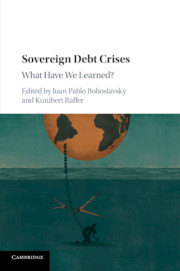Book contents
- Sovereign Debt Crises
- Sovereign Debt Crises
- Copyright page
- Dedication
- Contents
- Contributors
- 1 Introduction
- 2 Managing Public Debt Crisis in Argentina
- 3 Why Developing Countries Should Not Incur Foreign Debt
- 4 Ecuador’s 2008–2009 Debt Restructuring
- 5 Greece: An EU-Inflicted Catastrophe*
- 6 Grenada: A Small Island Developing State Needs New Ways Out of Its Debt
- 7 Iceland: A Human Rights-Sensitive Approach to Deal with Financial Crises
- 8 Indonesia’s 1997–1998 Economic Crisis
- 9 The Irish Sovereign Debt Crisis Post-2009
- 10 Short-Term Capital Controls and Malaysia’s Fast Recovery after the East-Asian Crisis
- 11 Sovereign Debt
- 12 Portugal’s Austerity Bailout
- 13 Don’t Waste a Serious Crisis*
- 14 Lessons from South Korea
- 15 The Spanish Crisis
- 16 Conclusions
- Index
5 - Greece: An EU-Inflicted Catastrophe*
Published online by Cambridge University Press: 16 November 2017
- Sovereign Debt Crises
- Sovereign Debt Crises
- Copyright page
- Dedication
- Contents
- Contributors
- 1 Introduction
- 2 Managing Public Debt Crisis in Argentina
- 3 Why Developing Countries Should Not Incur Foreign Debt
- 4 Ecuador’s 2008–2009 Debt Restructuring
- 5 Greece: An EU-Inflicted Catastrophe*
- 6 Grenada: A Small Island Developing State Needs New Ways Out of Its Debt
- 7 Iceland: A Human Rights-Sensitive Approach to Deal with Financial Crises
- 8 Indonesia’s 1997–1998 Economic Crisis
- 9 The Irish Sovereign Debt Crisis Post-2009
- 10 Short-Term Capital Controls and Malaysia’s Fast Recovery after the East-Asian Crisis
- 11 Sovereign Debt
- 12 Portugal’s Austerity Bailout
- 13 Don’t Waste a Serious Crisis*
- 14 Lessons from South Korea
- 15 The Spanish Crisis
- 16 Conclusions
- Index
Summary
To service its debt burden would require Greece to operate as a quasi slave economy, running a primary surplus of 5 per cent of GDP for years, purely for the benefit of its foreign creditors.
Financial Times, 26 January 2015It’s uncontroversial that debt relief is necessary and I think that nobody has ever disputed that. The issue is what is the best form of debt relief within our framework, within our legal institutional framework.
Mario Draghi, Guardian, 16 July 2015Greece is a striking example of how politicians can mess up a simple and easy-to-solve problem, purporting to ‘rescue’ an insolvent sovereign and transforming a minor problem into outright catastrophe. Greece’s debt burden has increased substantially since ‘rescue’ started, her GDP has shrunk sizeably, avoidable damages have been inflicted on Greece’s people and economy, taxpayers in other euro-member states and the private sector. Future capital market access for euro-countries may be damaged. The European Central Bank was brought into the delicate position of a bad bank, even a public ‘vulture’. Future speculation against euro-countries may have been encouraged. Democracy and human rights were two main casualties of EU debt ‘management’. Technically unfounded fears about the survival of the common currency had been triggered. A good part of taxpayers’ money illegally used for Greece’s ‘bailout’ is definitely lost. The FT defined Greece as a ‘quasi slave economy’ run for the benefit of its (official) creditors. Inflicting more damages seems technically impossible. Draghi’s statement that it has been ‘uncontroversial that debt relief is necessary and nobody has ever disputed that’ raises questions this chapter will discuss. If so, why was debt relief not implemented in 2010, which would have been in the best interest for anyone but some speculators and EU functionaries? Why does the Troika still shun this necessary solution at the cost of violating basic human rights? Why did the Troika increase the debt overhang, creating more phantom debts? Who has benefitted from that strategy? This chapter will discuss these issues, also showing which avoidable damages have been illegally inflicted on Greece by the EU. It will very briefly compare Greece with other insolvent countries and advocate Raffer’s model of sovereign insolvency as the best and necessary solution.
- Type
- Chapter
- Information
- Sovereign Debt CrisesWhat Have We Learned?, pp. 65 - 83Publisher: Cambridge University PressPrint publication year: 2017



